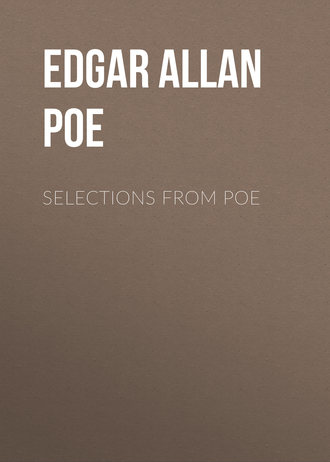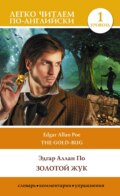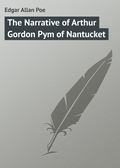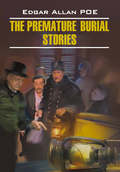
Эдгар Аллан По
Selections from Poe
LITERARY WORK
Poe's first literary ventures were in verse. The early volumes, showing strongly the influence of Byron and Moore, were productions of small merit but large promise. Their author was soon to become one of the most original of poets, his later work being unique, with a strangely individual, "Poe" atmosphere that no other writer has ever been able successfully to imitate. His verse is individual in theme, treatment, and structure, all of which harmonize with his conscious theory of poetic art. His theory is briefly this: It is not the function of poetry to teach either truth or morals, but to gratify through novel forms "the thirst for supernal beauty"; its proper effect is to "excite, by elevating, the soul." The highest beauty has always some admixture of sadness, the most poetical of all themes being the death of a beautiful woman. Moreover, the pleasure derived from the contemplation of this higher beauty should be indefinite; that is, true poetic feeling is not the result of coherent narrative or clear pictures or fine moral sentiment, but consists in vague, exalted emotion. Music, of all the arts, produces the vaguest and most "indefinite" pleasure; consequently verse forms should be chosen with the greatest possible attention to musical effect. Poetry must be purely a matter of feeling. "Its sole arbiter is Taste. With the Intellect or with the Conscience it has only collateral relations."
This explanation is necessary, because the stock criticism of Poe's poetry condemns it as vague, indefinite, and devoid of thought or ethical content. These are precisely its limitations, but hardly its faults, since the poet attained with marvelous art the very effects he desired. The themes of nearly all the poems are death, ruin, regret, or failure; the verse is original in form, and among the most musical in the language, full of a haunting, almost magical melody. Mystery, symbolism, shadowy suggestion, fugitive thought, elusive beauty, beings that are mere insubstantial abstractions – these are the characteristics, but designedly so, of Poe's poetry. A poem to him was simply a crystallized mood, and it is futile for his readers to apply any other test. Yet the influence of this verse has been wide and important, extending to most lyric poets of the last half-century, including such masters as Rossetti and Swinburne.
"To Helen," a poem of three brief stanzas, is Poe's first really notable production; it is an exquisite tribute of his reverent devotion to his boyhood friend, Mrs. Stannard, portraying her as a classic embodiment of beauty. "Israfel" is a lyric of aspiration of rare power and rapture, worthy of Shelley, and is withal the most spontaneous, simple, and genuinely human poem Poe ever wrote. "The Haunted Palace," one of the finest of his poems, is an unequaled allegory of the wreck and ruin of sovereign reason, which to be fully appreciated should be read in its somber setting, "The Fall of the House of Usher." Less attractive is "The Conqueror Worm," with its repulsive imagery, but this "tragedy 'Man,'" with the universe as a theater, moving to the "music of the spheres," and "horror the soul of the plot," is undeniably powerful and intensely terrible.
"The Raven," published in 1845, attained immediately a world-wide celebrity, and rivals in fame and popularity any lyric ever written. It is the most elaborate treatment of Poe's favorite theme, the death of a beautiful woman. The reveries of a bereaved lover, alone in his library at midnight in "the bleak December," vainly seeking to forget his sorrow for the "lost Lenore," are interrupted by a tapping, as of some one desirous to enter. After a time, he admits a "stately raven" and seeks to beguile his sad fancy by putting questions to the bird, whose one reply is "Nevermore," and this constitutes the refrain of the poem. Impelled by an instinct of self-torture, the lover asks whether he shall have "respite" from the painful memories of "Lenore," here or hereafter, and finally whether in the "distant Aidenn" he and his love shall be reunited; to all of which the raven returns his one answer. Driven to frenzy, the lover implores the bird, "Take thy beak from out my heart, and take thy form from off my door," only to learn that the shadow will be lifted "nevermore." The raven is, in the poet's own words, "emblematical of Mournful and Never-Ending Remembrance."
"Ulalume" has been commonly (though not always) regarded as a mere experiment in verbal ingenuity, meaningless melody, or "the insanity of versification," as a distinguished American critic has called it. Such a judgment is a mark of inability to understand Poe's most characteristic work, for in truth "Ulalume" is the extreme expression at once of his critical theory and of his peculiar genius as a poet. It was published in December of the same year in which Virginia died in January. The poet's condition has already been described; "Ulalume" is a marvelous expression of his mood at this time. It depicts a soul worn out by long suffering, groping for courage and hope, only to return again to "the door of a legended tomb." It is true the movement is slow, impeded by the frequent repetitions, but so the wearied mind, after nervous exhaustion, is "palsied and sere." There is no appeal to the intellect, but this is characteristic of Poe and appropriate to a mind numbed by protracted suffering. It is this mood of wearied, benumbed, discouraged, hopeless hope, feebly seeking for the "Lethean peace of the skies" only to find the mind inevitably reverting to the "lost Ulalume," that finds expression. There is no definite thought, because only the communication of feeling is intended; there is no distinct setting, because the whole action is spiritual; "the dim lake" and "dark tarn of Auber," "the ghoul-haunted woodland of Weir," "the alley Titanic of cypress," are the grief-stricken and fear-haunted places of the poet's own darkened mind, while the ashen skies of "the lonesome October" are significant enough of this "most immemorial year." The poem is a monody of nerveless, exhausted grief. As such it must be read to be appreciated, as such it must be judged, and so appreciated and so judged it is absolutely unique and incomparable.
About a year later came "The Bells," wonderful for the music of its verse, and the finest onomatopoetic poem in the language. Two days after Poe's death appeared "Annabel Lee," a simple, sincere, and beautiful ballad, a tribute to his dead wife. Last of all was printed the brief "Eldorado," a fitting death-song for Poe, in which a gallant knight sets out, "singing a song," "in search of Eldorado," only to learn when youth and strength are gone that he must seek his goal "down the Valley of the Shadow."
The tales, like the poems, are a real contribution to the world's literature, but more strikingly so, since the type itself is original. Poe, Hawthorne, and Irving are distinctly the pioneers in the production of the modern short story, and neither has been surpassed on his own ground; but Poe has been vastly the greater influence in foreign countries, especially in France. Poe formed a new conception of the short story, one which Professor Brander Matthews4 has treated formally and explicitly as a distinct literary form, different from the story that is merely short. Without calling it a distinct form, Poe implied the idea in a review of Hawthorne's "Twice-Told Tales":
The ordinary novel is objectionable from its length… As it cannot be read at one sitting, it deprives itself, of course, of the immense force derivable from totality… In the brief tale, however, the author is enabled to carry out the fulness of his intention, be it what it may. During the hour of perusal, the soul of the reader is at the writer's control…
A skillful literary artist has constructed a tale. If wise, he has not fashioned his thoughts to accommodate his incidents; but having conceived with deliberate care a certain unique or single effect to be wrought out, he then invents such incidents – he then combines such events as may best aid him in establishing this preconceived effect. If his very initial sentence tend not to the out-bringing of this effect, then he has failed in his first step. In the whole composition there should be no word written, of which the tendency, direct or indirect, is not to the one preëstablished design.
This idea of a short story should be kept in mind in reading Poe's works, for he applied his theory perfectly.
The stories are of greater variety than the poems. There are romances of death whose themes are fear, horror, madness, catalepsy, premature burial, torture, mesmerism, and revengeful cruelty; tales of weird beauty; allegories of conscience; narratives of pseudo-science; stories of analytical reasoning; descriptions of beautiful landscapes; and what are usually termed "prose poems." He also wrote tales grotesque, humorous, and satirical, most of which are failures. The earlier tales are predominantly imaginative and emotional; most of the later ones are predominantly intellectual. None of the tales touches ordinary, healthy life; there is scarcely a suggestion of local color; the humor is nearly always mechanical; there is little conversation and the characters are never normal human beings. Although the stories are strongly romantic in subject, plot, and setting, there is an extraordinary realism in treatment, a minuteness and accuracy of detail equaling the work of Defoe. This is one secret of the magical art that not only transports us to the world of dream and vision where the author's own soul roamed, but for the time makes it all real to us.
Poe's finest tale, as a work of art, is "The Fall of the House of Usher," which is as nearly perfect in its craftsmanship as human work may be. It is a romance of death with a setting of profound gloom, and is wrought out as a highly imaginative study in fear – a symphony in which every touch blends into a perfect unity of effect. "Ligeia," perhaps standing next, incorporating "The Conqueror Worm" as its keynote, portrays the terrific struggle of a woman's will against death. "The Masque of the Red Death," a tale of the Spirit of Pestilence and of Death victorious over human selfishness and power, is a splendid study in somber color. "The Assignation," a romance of Venice, is also splendid in coloring and rich in decorative effects, presenting a luxury of sorrow culminating in romantic suicide. "William Wilson" is an allegory of conscience personified in a double, the forerunner of Stevenson's "Dr. Jekyll and Mr. Hyde." Other conscience stories are "The Man of the Crowd"; "The Tell-Tale Heart," also depicting insanity; and "The Black Cat," of which the atmosphere is horror. "The Adventures of One Hans Pfaal" and "The Balloon Hoax" are examples of the pseudo-scientific tales, which attain their verisimilitude by diverting attention from the improbability or impossibility of the general incidents to the accuracy and naturalness of details. In "The Descent into the Maëlstrom," scientific reasoning is skillfully blended with imaginative strength, poetic description, and stirring adventure. This type of story is clearly enough the original of those of Jules Verne and similar writers. "The Murders in the Rue Morgue" and "The Purloined Letter" are the pioneer detective stories, Dupin the original Sherlock Holmes, and they remain the best of their kind, unsurpassed in originality, ingenuity, and plausibility. Another type of the story of analytical reasoning is "The Gold-Bug," built around the solution of a cryptogram, but also introducing an element of adventure. Poe's analytical power was real, not a trick. If he made Legrand solve the cryptogram and boast his ability to solve others more difficult, Poe himself solved scores sent him in response to a public magazine challenge; if Dupin solved mysteries that Poe invented for him, Poe himself wrote in "Marie Roget," from newspaper accounts, the solution of a real murder mystery, and astounded Dickens by outlining the entire plot of "Barnaby Rudge" when only a few of the first chapters had been published; if he wrote imaginatively of science, he in fact demonstrated in "Maelzel's Chess Player" that a pretended automaton was operated by a man. "Hop Frog" and "The Cask of Amontillado" are old-world stories of revenge. "The Island of the Fay" and "The Domain of Arnheim" are landscape studies, the one of calm loveliness, the other of Oriental profusion and coloring. "Shadow" and "Silence" are commonly classed as "prose poems," the former being one of Poe's most effective productions. "Eleonora," besides having a story to tell, is both a prose poem and a landscape study, and withal one of Poe's most exquisite writings.
Although Poe was not a great critic, his critical work is by no means valueless. He applied for the first time in America a thoroughgoing scrutiny and able, fearless criticism to contemporary literature, undoubtedly with good effect. His attacks on didacticism were especially valuable. His strength as a critic lay in his artistic temperament and in the incisive intellect that enabled him to analyze the effects produced in his own creations and in those of others. His weaknesses were extravagance; a mania for harping on plagiarism; lack of spiritual insight, broad sympathies, and profound scholarship; and, in general, the narrow range of his genius, which has already been made sufficiently clear. His severity has been exaggerated, as he often praised highly, probably erring more frequently by undue laudation than by extreme severity. Though personal prejudice sometimes crept into his work, especially in favor of women, yet on the whole he was as fair and fearless as he claimed to be. Much of the hasty, journalistic hack work is valueless, as might be expected, but he wrote very suggestively of his art, and nearly all his judgments have been sustained. Moreover, he met one supreme test of a critic in recognizing unknown genius: Dickens he was among the first to appraise as a great novelist; Tennyson and Elizabeth Barrett (Browning) he ranked among the great poets without hesitation; and at home he early expressed a due appreciation of Hawthorne, Lowell, Longfellow, and Bryant.
Poe's place, both in prose and poetry, is assured. His recognition abroad has been clear and emphatic from the first, especially in France, and to-day foreigners generally regard him as the greatest writer we have produced, an opinion in which a number of our own critics and readers concur. One's judgment in the matter will depend upon the point of view and the standards adopted; it is too large a subject to consider here, but if artistic craftsmanship be the standard, certainly Hawthorne would be his only rival, and Hawthorne was not also a poet. The question of exact relative rank, however, it is neither possible nor important to settle. It is sufficient to say, in the words of Professor Woodberry, "On the roll of our literature Poe's name is inscribed among the few foremost, and in the world at large his genius is established as valid among all men."
BIBLIOGRAPHY
The year after Poe's death there appeared "The Works of the Late Edgar Allan Poe," with a Memoir, in two volumes, edited by R. W. Griswold and published by J. S. Redfield, New York. The same editor and publisher brought out a four-volume edition in 1856. Griswold had suffered from Poe's sharp criticisms and had quarreled with him, though later there was a reconciliation, and Poe himself selected Griswold to edit his works. The biographer painted the dead author very black indeed, and his account is now generally considered unfair.
In 1874-1875 "The Works of Edgar Allan Poe," with Memoir, edited by John H. Ingram, were published in four volumes, in Edinburgh, and in 1876 in New York. Ingram represents the other extreme from Griswold, attempting to defend practically everything that Poe was and did.
In 1884 A. C. Armstrong & Son, New York, brought out "The Works of
Edgar Allan Poe" in six volumes, with an Introduction and Memoir by
Richard Henry Stoddard. Stoddard is far from doing justice to Poe either as man or as author.
Although Griswold's editing was poor, subsequent editions followed his until 1895, when Professor George E. Woodberry and Mr. Edmund Clarence Stedman published a new edition in ten volumes through Stone & Kimball, Chicago (now published by Duffield & Company, New York). This edition is incomparably superior to all its predecessors, going to the original sources, and establishing an authentic text, corrected slightly in quotations and punctuation. Professor Woodberry contributed a Memoir, and Mr. Stedman admirable critical articles on the poems and the tales. Scholarly notes, an extensive bibliography, a number of portraits, and variorum readings of the poems, are included.
In 1902 T.Y. Crowell & Company, New York, issued "The Complete Works of Edgar Allan Poe" in seventeen volumes, edited by Professor James A. Harrison, including a biography and a volume of letters. This edition contains much of Poe's criticism not published in previous editions, and follows Poe's latest text exactly; complete variorum readings are included.
In 1902 there also appeared "The Booklover's Arnheim" edition in ten volumes, edited by Professor Charles F. Richardson and published by G.P. Putnam's Sons, New York. This is mechanically the finest edition of Poe's works.
The one-volume collections of poems and of tales are almost innumerable, but nearly all are devoid of merit and poorly edited in selection, text, and notes. (This does not refer to the small collections for study in schools.) The best are the following: "Tales of Mystery," Unit Book Publishing Company, New York (72 cents); "The Best Tales of Edgar Allan Poe," edited with critical studies by Sherwin Cody, A.C. McClurg & Company, Chicago ($1.00); "The Best Poems and Essays of E. A. Poe," edited with biographical and critical introduction by Sherwin Cody, McClurg ($1.00); "Poems of E. A. Poe," complete, edited and annotated by Charles W. Kent, The Macmillan Company, New York (25 cents).
Professor George E. Woodberry contributed in 1885 a volume on Poe to the American Men of Letters Series (Houghton, Mifflin & Co., Boston), which is the ablest yet written. In scholarship and critical appreciation it is all that could be desired, but unfortunately it is unsympathetic. Mr. Woodberry assumed a coldly judicial attitude, in which mood he is occasionally a little less than just to Poe's character. Professor Harrison's biography, written for the Virginia edition, is published separately by T.Y. Crowell & Company. It is very full, and valuable for the mass of material supplied, but is not discriminating in criticism or estimate of Poe's character.
Numerous magazine articles may be found by consulting the periodical indexes. A number of suggestive short studies are to be found in the text-books of American literature, such as those of Messrs. Trent, Abernethy, Newcomer, and Wendell; and in the larger books of Professors Richardson, Trent, and Wendell. One may also find acute and valuable comment in such works as Professor Bliss Perry's "A Study of Prose Fiction," and Professor Brander Matthews's "Philosophy of the Short-Story" (published separately, and in "Pen and Ink").
Many of Poe's tales and poems have been translated into practically all the important languages of modern Europe, including Greek. An important French study of Poe, recently published, is mentioned in the Preface.
POEMS
SONG
I saw thee on thy bridal day,
When a burning blush came o'er thee,
Though happiness around thee lay,
The world all love before thee;
And in thine eye a kindling light
(Whatever it might be)
Was all on Earth my aching sight
Of loveliness could see.
That blush, perhaps, was maiden shame:
As such it well may pass,
Though its glow hath raised a fiercer flame
In the breast of him, alas!
Who saw thee on that bridal day,
When that deep blush would come o'er thee,
Though happiness around thee lay,
The world all love before thee.





